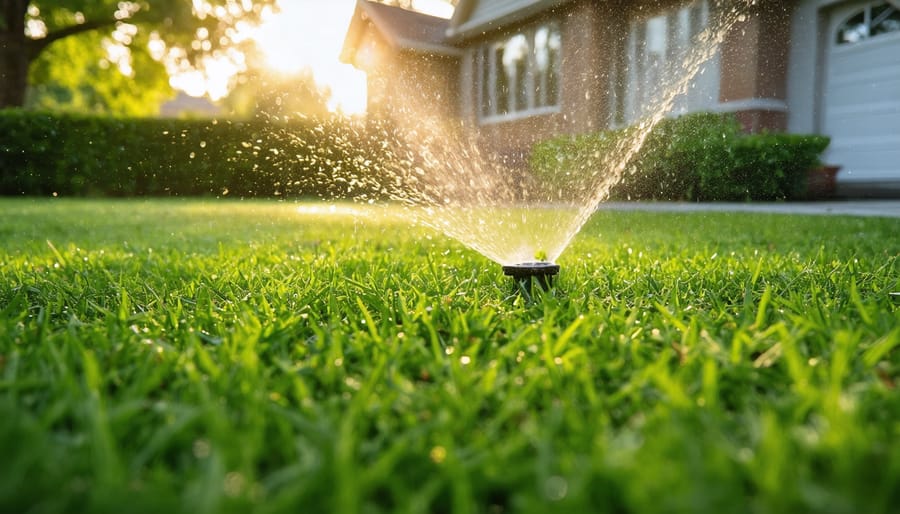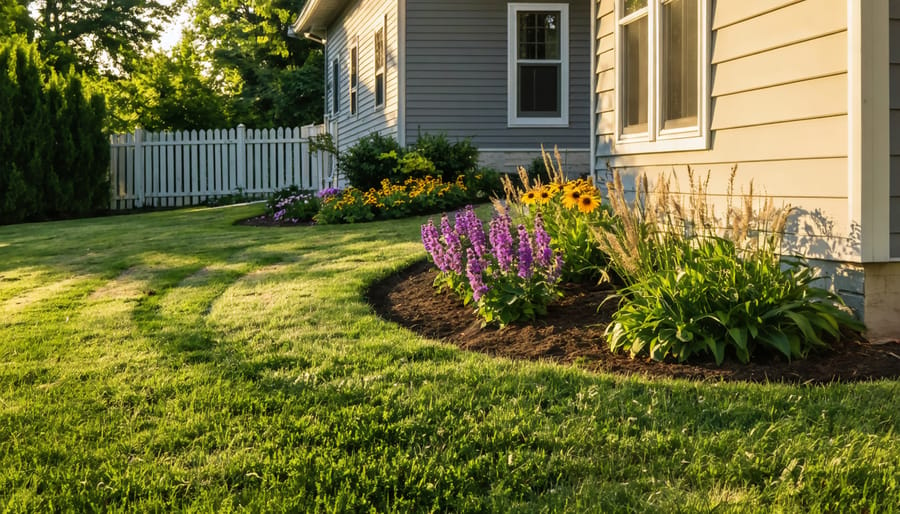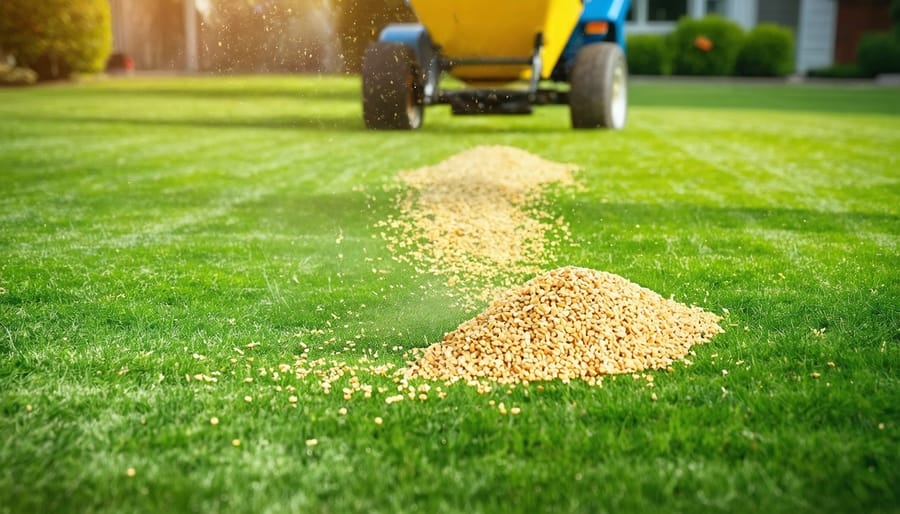Transform your summer lawn into a drought-resistant oasis by mowing at a higher setting – keeping grass blades at 3-4 inches helps shade the soil, reduce water evaporation, and promote deeper root growth. Water deeply but infrequently, delivering 1-1.5 inches of water per week during early morning hours to maximize absorption and minimize waste. Combat heat stress by incorporating organic matter into your soil through top dressing with compost, which improves water retention and nurtures beneficial microorganisms that strengthen grass resilience. Strategic maintenance during intense summer heat isn’t just about survival – it’s about creating a sustainable, vibrant lawn that thrives while conserving precious water resources. Follow these proven techniques to maintain a healthy, green lawn that stands up to summer’s challenges without compromising environmental responsibility or your water bill.
Smart Watering Strategies for Summer Success
Best Time to Water Your Lawn
Timing is crucial when it comes to watering your lawn during summer. The optimal time to water is early morning, ideally between 4 AM and 10 AM. This timing allows water to penetrate deeply into the soil before the heat of the day causes excessive evaporation. Plus, morning watering gives grass blades time to dry, reducing the risk of fungal diseases that thrive in prolonged moisture.
Avoid evening watering whenever possible. While it might seem logical to water when temperatures cool down, leaving your grass wet overnight can promote fungal growth and other lawn diseases. If morning watering isn’t feasible, late afternoon (between 4 PM and 6 PM) is your next best option, giving the grass time to dry before nightfall.
Understanding efficient irrigation methods is just as important as timing. Deep, infrequent watering encourages deeper root growth, making your lawn more drought-resistant. Aim to water 1-1.5 inches per week, either in a single session or split into two waterings. During extreme heat, you might need to adjust this schedule, but remember that overwatering can be just as harmful as underwatering.
Monitor your lawn’s response and local weather conditions. If rain is forecasted, adjust your watering schedule accordingly. A simple rain gauge can help you track natural precipitation and adjust your supplemental watering as needed. Remember, a healthy lawn doesn’t need daily watering – less frequent, deeper watering produces stronger, more resilient grass.

Deep Watering vs. Light Sprinkling
When it comes to watering your lawn during summer, there’s a significant difference between deep watering and light sprinkling – and your grass definitely has a preference! Deep watering encourages roots to grow deeper into the soil, creating a more resilient and drought-resistant lawn.
Think of it this way: light, frequent sprinklings are like giving your lawn tiny sips of water that only reach the surface. This encourages shallow root growth and makes your grass more vulnerable to heat stress and drought. Instead, aim for less frequent but deeper watering sessions that allow water to penetrate 6-8 inches into the soil.
To implement deep watering effectively, water your lawn for longer periods but less often – typically 2-3 times per week rather than daily. A good rule of thumb is to apply about 1-1.5 inches of water per session. You can easily measure this by placing a few empty tuna cans around your lawn while watering. When they’re filled to the appropriate level, you’ve provided enough water.
The best time for deep watering is early morning, between 4 AM and 10 AM. This timing allows water to soak into the soil before evaporation becomes significant and helps prevent fungal growth that can occur with evening watering.
Some key benefits of deep watering include:
– Stronger, deeper root systems
– Better drought tolerance
– Reduced weed growth
– More efficient water usage
– Healthier, more resilient grass
Remember to adjust your watering schedule based on rainfall and local weather conditions. If you’re unsure whether it’s time to water, try the footprint test: step on your lawn, and if the grass doesn’t spring back up, it’s time for a deep watering session. This approach not only creates a healthier lawn but also promotes water conservation and environmental sustainability.
Drought-Resistant Mowing Techniques
Optimal Mowing Height for Summer
During the heat of summer, adjusting your mowing height is one of the most crucial steps in maintaining a healthy, resilient lawn. While it might be tempting to cut your grass short to extend the time between mowings, taller grass actually provides numerous benefits during hot weather.
The ideal summer mowing height for most grass types is between 3 to 4 inches – about an inch higher than spring mowing heights. This increased height helps your lawn in several important ways. Taller grass develops deeper root systems, which can access water sources further below the surface. The added height also creates natural shade for the soil, reducing water evaporation and helping to keep grass roots cooler during intense heat.
Before you start mowing at this higher setting, ensure you’re maintaining your lawn mower properly, including sharpening the blades for clean cuts that won’t stress your grass. When mowing, follow the “one-third rule” – never remove more than one-third of the grass blade length in a single cutting. This prevents shock to the grass and promotes healthier growth.
You’ll know you’re mowing at the right height when your lawn maintains a rich green color and shows good resistance to browning during dry spells. If you notice your grass looking stressed or turning brown quickly between waterings, try raising the cutting height another half-inch.
Remember that different grass types may have slightly different optimal heights. Cool-season grasses like Kentucky Bluegrass and Fescue generally benefit from the higher end of the range, while warm-season varieties like Bermuda can often be maintained slightly shorter. However, during peak summer heat, err on the side of leaving your grass a bit longer rather than shorter.
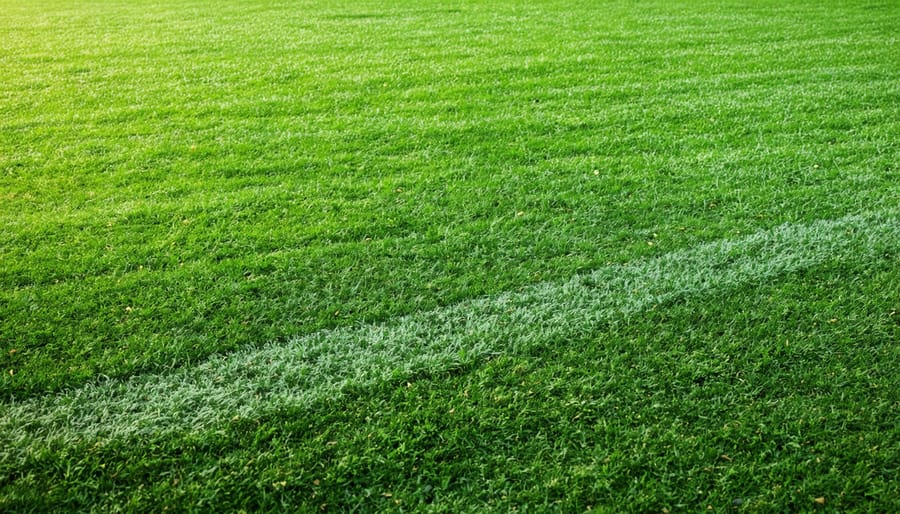
Mowing Frequency Adjustments
During drought conditions, adapting your mowing schedule becomes crucial for maintaining a healthy lawn while conserving resources. Instead of sticking to a rigid weekly schedule, learn to read your lawn’s growth patterns and adjust accordingly.
A good rule of thumb during dry spells is to raise your mower blade height by at least half an inch. Taller grass develops deeper roots, which can access water stored further in the soil. This simple adjustment helps your lawn become more drought-resistant and reduces the frequency of necessary mowing.
Watch for signs that your lawn needs mowing rather than following a set schedule. The “one-third rule” becomes especially important during summer – never cut more than one-third of the grass blade length in a single mowing session. If your usual mowing height is 2 inches, wait until the grass reaches about 3 inches before cutting.
During severe drought, your lawn may go dormant and slow its growth significantly. This is a natural survival mechanism, and it’s perfectly acceptable to reduce mowing frequency to once every 2-3 weeks. Forcing yourself to mow weekly during these periods can stress the grass unnecessarily and potentially damage your lawn.
However, when rain returns or if you’re maintaining irrigation, you might need to mow more frequently to keep up with renewed growth. Be flexible with your schedule and observe how your grass responds to changing weather conditions.
Remember to mow during cooler parts of the day, preferably in the early morning or late afternoon. This timing reduces stress on both the grass and the person mowing. Also, leave grass clippings on the lawn during drought periods – they help retain moisture and return valuable nutrients to the soil.
By adapting your mowing schedule to drought conditions, you’re not just maintaining appearances; you’re helping your lawn build resilience for future dry spells while practicing responsible water conservation.
Soil Care During Drought
Mulching and Grass Clipping Management
Mulching and grass clipping management are two of the most effective ways to maintain a healthy lawn while promoting sustainability during the summer months. Rather than bagging and disposing of your grass clippings, leaving them on your lawn (known as grasscycling) can return valuable nutrients to the soil and help retain moisture.
When you mow your lawn, those small clippings break down quickly, returning up to 25% of the nitrogen content back to the soil. This natural fertilization process reduces the need for synthetic fertilizers and helps create a more resilient lawn. However, ensure your mower blade is sharp and you’re cutting no more than one-third of the grass blade length to prevent clumps that could smother the grass beneath.
Adding a layer of organic mulch around trees and in garden beds adjacent to your lawn serves multiple purposes. It helps maintain soil moisture, reduces weed growth, and gradually improves soil structure as it decomposes. For the best results, apply a 2-3 inch layer of organic mulch, keeping it slightly away from tree trunks and plant stems to prevent rot.
Consider using compost as a top dressing for your lawn, spreading a thin layer (about ¼ inch) across the surface. This practice, known as topdressing, helps improve soil structure, enhances moisture retention, and provides essential nutrients for your grass. The best time to apply compost is after aerating your lawn, as this allows the organic matter to penetrate deeper into the soil.
During periods of intense heat, these organic practices become even more crucial. The combination of mulching and proper grass clipping management can reduce water requirements by up to 30% while maintaining a lush, green lawn. Remember to adjust your mowing height slightly higher during summer months, as longer grass blades provide natural shade for the soil and help prevent moisture loss.

Soil Aeration and Amendment Tips
Healthy soil is the foundation of a vibrant lawn, and knowing how to improve soil quality can make all the difference during challenging summer months. The key to maintaining a thriving lawn lies in proper soil aeration and amendment techniques that promote strong root growth and efficient water absorption.
Let’s start with aeration – a crucial practice that many homeowners overlook. The benefits of lawn aeration are numerous, including better water penetration, reduced soil compaction, and improved nutrient absorption. For best results, aerate your lawn during the growing season when the soil is moist but not waterlogged. You can choose between spike or core aerators, though core aerators are generally more effective as they remove small plugs of soil, creating channels for air, water, and nutrients.
After aeration, it’s the perfect time to amend your soil. Consider adding a mix of organic matter such as compost, well-rotted manure, or leaf mold. These amendments improve soil structure, enhance microbial activity, and increase the soil’s water-holding capacity – particularly valuable during hot summer months.
Here’s a practical tip: spread a thin layer (about ¼ inch) of compost over your lawn after aeration. This practice, known as topdressing, helps fill the aeration holes while adding valuable nutrients to the soil. For clay-heavy soils, consider incorporating gypsum to improve drainage and reduce compaction. Sandy soils benefit from the addition of organic matter to better retain moisture and nutrients.
Remember to test your soil pH annually and adjust accordingly. Most grasses prefer slightly acidic to neutral soil (pH 6.0-7.0). If needed, add lime to raise pH or sulfur to lower it. These amendments should be applied gradually over time to avoid shocking your lawn’s ecosystem.
For sustainable results, make soil improvement a regular part of your lawn care routine, focusing on building healthy soil structure rather than quick fixes.
Signs of Drought Stress and Recovery Methods
Early Warning Signs
Your lawn will send clear distress signals when it’s struggling with drought conditions, and catching these early warning signs can help you take action before serious damage occurs. The first and most noticeable indicator is a change in color – your grass will begin to take on a bluish-gray tint before turning straw-colored or brown. This discoloration often starts in patches and gradually spreads across the lawn.
Watch for footprints that remain visible long after someone has walked across the grass. In a healthy lawn, grass blades quickly spring back up, but drought-stressed grass lacks the moisture needed to recover its upright position. You might also notice the grass blades folding or rolling inward, which is the plant’s natural mechanism to reduce water loss.
Another telling sign is when your lawn begins to lose its bounce. Healthy grass should feel springy under your feet, but drought-stressed turf often feels hard and compact. The soil might also show signs of shrinkage, creating small cracks or gaps, particularly in clay-heavy areas.
Pay special attention to areas that typically show stress first, such as slopes, areas near driveways or walkways, and spots that receive intense afternoon sun. These zones can serve as early indicators for the rest of your lawn’s health, giving you time to adjust your watering schedule before widespread damage occurs.
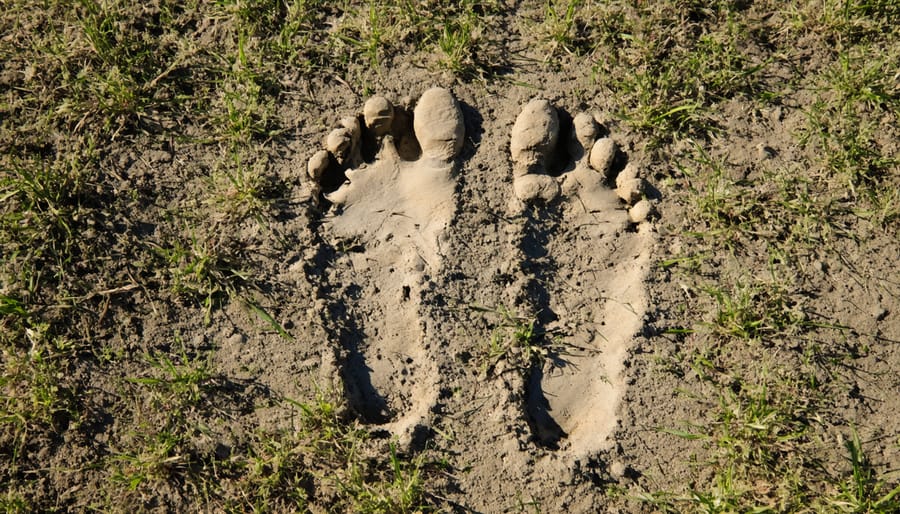
Recovery Strategies
When your lawn shows signs of drought stress, don’t worry – there are several effective strategies to help it recover. First, resist the urge to mow immediately after a dry spell ends. Give your grass time to bounce back naturally, waiting until it shows signs of active growth before the first post-drought trim.
Once rain returns or irrigation becomes available, water deeply but infrequently. This encourages roots to grow deeper, making your lawn more resilient for future dry spells. Apply about 1 inch of water per session, preferably early in the morning to minimize evaporation.
Consider overseeding with drought-tolerant grass varieties in areas that suffered significant damage. These hardy grasses will help create a more resilient lawn that can better withstand future dry periods.
Aeration can work wonders for recovery, allowing water and nutrients to penetrate more effectively into the soil. Follow this with a light application of compost or organic fertilizer to provide essential nutrients for recovery. Keep the fertilizer application minimal – too much can stress recovering grass.
Finally, reduce foot traffic on recovering areas by temporarily redirecting pathways or marking off sensitive spots. Remember, patience is key during the recovery process – it may take several weeks for your lawn to fully bounce back to its former glory.
Maintaining a beautiful lawn during summer doesn’t have to conflict with environmental responsibility. By following the maintenance practices we’ve discussed, you can achieve that perfect balance between a healthy, attractive lawn and water conservation. Remember that the key lies in smart watering techniques – deep but infrequent watering sessions that encourage deep root growth while minimizing water waste.
Regular mowing at the right height, typically keeping grass between 2.5 to 3.5 inches tall during summer, helps create a more resilient lawn that naturally resists drought and weeds. Combined with proper fertilization timing and thoughtful weed management, these practices form the foundation of sustainable lawn care.
Don’t forget that a healthy lawn is your best defense against summer stress. By maintaining proper soil health, addressing issues promptly, and adapting your care routine to weather conditions, you can keep your lawn looking its best while being a responsible steward of our water resources.
As we face increasing environmental challenges, it’s crucial to embrace lawn care practices that protect both our outdoor spaces and our natural resources. With these strategies in place, you can enjoy a vibrant, green lawn throughout the summer months while knowing you’re doing your part for water conservation. Remember, a sustainable approach to lawn care isn’t just good for the environment – it’s also the best way to ensure your lawn stays healthy and beautiful for years to come.

